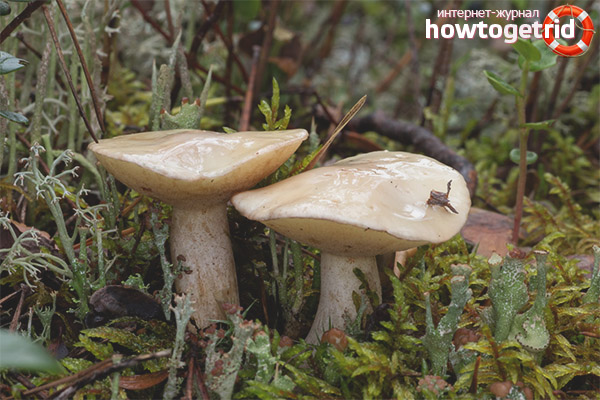The content of the article
White butterdish is one of the popular edible tubular representatives of the Maslenkov family, belonging to the class of agaricomycetes, characterized by slightly pronounced taste and practically no noticeable smell. The official Latin international name is Suillus placidus.
Description
The cap of the white oiler has an average diameter of 5 to 12 centimeters, although it is quite possible to find single specimens that exceed this indicator. In a young fungus, it differs in a convex shape, in the process of gradual growth, first taking on a pillow-shaped appearance, and then flat, or even slightly concave. The surface is smooth and slightly moist, due to the presence of a thin layer of mucus on it, upon drying of which the skin becomes shiny.
As you can easily guess from the name of this type of butter, it has a whitish neutral color of the hat, the edges of which, however, have a pale yellow tint. In a mature mushroom, this part can be painted in yellowish-white or grayish-white color, and in rainy weather it often resembles dull olives with its appearance. The peel is easily separated from the cap, and it quickly collapses.
The tubular part of the oiler is connected to the leg in a fused state, sometimes in nature you can meet this mushroom, which has tubes that are slightly descending in shape. The color of this area is first whitish yellow, then, as it grows older, it turns first into a more pronounced and saturated yellow (like a lemon peel), then into a greenish yellow (characteristic of olives), and in the oldest state - into an olive brown . A similar color has the rounded, angular in shape pores of the fungus, in which droplets of red liquid can often be found.
The pulp of a white oiler differs in yellow or white color, in the place of a cut or a break gradually change over time and turns into a wine red tint. The mushroom has a mild smell and taste. It has smooth, elliptical spores with a light brown, yellow olive or ocher-colored powder.
Growth

White oiler grows mainly in mixed-type forests inhabited by conifers, next to representatives of cedar and various pine varieties. The main areas of its growth are China and North America, Europe and Russia, where it can be found in especially large quantities on the territory of Siberia and remote regions of the Far East. The growth of the fungus occurs in the period from the beginning of summer, namely from June to November, and the collection is best carried out from August to September. It was at this time that this variety of mushrooms is best suited for food. It grows singly or as part of small groups, mainly next to the cedar - Siberian, European, dwarf, Korean. Thus, it is recommended to go to the collection of white oil in a nearby conifer, for example, in a young pine planting.Most often, the fungus grows singly, less often - in groups of 3 or 4 specimens, and is practically not seen in larger groups.
Edibility
Similar views
The white oiler does not have poisonous mushrooms similar to it, with which it could be easily confused, so even novice fans of the “silent hunt” can safely engage in its collection. But it is worth remembering its similarity with the so-called pepper mushroom - not poisonous, but having a very bitter taste, and therefore requiring at least 15 minutes of cooking, during which its bitterness is neutralized.










Submit